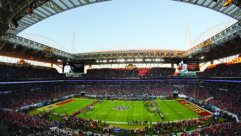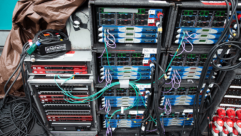Consumers want immersive experiences and this trend is on pace to intensify. The ability to capitalize on storytelling opportunities can serve as a critical differentiator for a theme park.
In a connected world where people are glued to their devices, theme park guests are looking for memorable out-of-home group experiences that allow them to escape from their always-on realities. This often means being able to create an atmosphere where the guests can feel like they – along with their friends and family – are part of the story. Whether the story revolves around the adventures of a favorite superhero or submersion into a mystical new world, nothing accomplishes this goal like the ability to personalize the experience. For example, feeling like you are taking on an active role to help your favorite superhero save the world.
The same technology that guests use every day to escape can play a meaningful support role in these theme park experience. For instance, the ability to leverage smartphones (and their associated data) delivers ways to personalize the experience—for example rewarding someone after their 50th time on a specific ride.
The use of strong IP and high-quality gaming engines makes interactive and totally immersive experiences a reality, and makes it possible to eliminate that pre-canned vibe. For instance, a dynamic attraction can maintain a common thread, yet utilize various randomly picked chapters to deliver varied outcomes. Although the story remains similar, it provides the guest with a new feel – encouraging them to come back repeatedly to continue the experience.
When it comes to logistics and guest satisfaction, park designers are recognizing that truly memorable experiences start with the elimination of guest headaches—especially long lines. As such, augmentation with mobile devices enables digital queues, eliminating the need to stand in line for an hour plus for each attraction. Both Disney and Universal have implemented their own versions of queue-less attractions. Utilizing a digital queue not only improves the experience by eliminating wait time it also creates additional revenue opportunities while guests spend money at concession stands, gift shops, and restaurants. Overall guest experience also improves with queue-less attractions.
At night, theme parks come alive with live shows; these will become more elaborate and immersive. They also serve as a significant revenue driver for people to have dinner, dessert and buy warm clothes because they get cold. The use of projector mapping will continue to play a key role in transforming the space while daily customization will increase for these recurring shows. For example, Disney projects current guest photos on the castle as part of their Once Upon a Time show.
Although Virtual Reality (VR) continues to generate buzz, there is a growing trend to reduce the use of visors, goggles or other virtual reality tools. They are often a maintenance nightmare that reduces capacity and remove guests from real-time group interaction. It was a great hook, and seemed a promising alternative to spending millions on a new attraction. But when patrons wear goggles, it’s not possible to see friends or family having fun as well – hampering the group experience that people desire.
Gamification is an opportunity to provide an additional immersive layer, especially for season pass holders. Gamification can combine complex games, puzzles—for example, directing guests through an escape room type experience or offering a unique ride as a reward through the use of the guest’s own mobile phone.
Behind the scenes, big data and AI fuel the growth of gamification opportunities. There’s a solid value proposition to leverage big data to make decisions and ultimately improve the guest experience. Of course, there needs to be a balance to respect privacy.
In general, guests have no desire to “see” the tools that are creating their experience. As such, there is a growing need to augment technology in ways that remain invisible or natural to the guest. For instance, the use of new high resolution, direct view LED displays essentially create “digital wallpaper” resulting in ultra-realistic digital caves or rooms that will transport guests to different worlds.
Lastly, it’s important to recognize the power of audio. Beautiful pictures quickly lose effectiveness without correlated sound. Increasing theme park designers can utilize complex sound movement capability to interact with guests.
Theme park magic has always been made of story, space and technology. Understanding how these fundamental elements converge for today’s audiences is the shared challenge for theme park designing professionals and collaborators.
Bryan Hinckley is President USA at Electrosonic.










